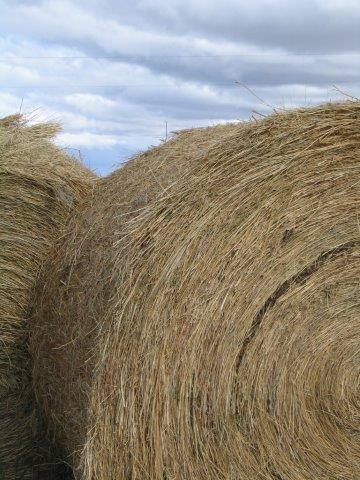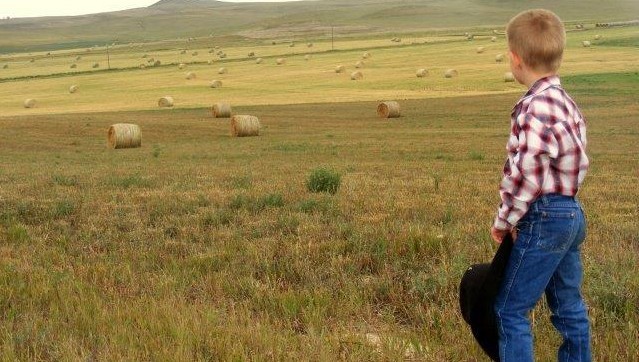Ag & Natural Resources
Forage Analysis

MSU Animal & Range Sciences Department
Hay production and pasture conditions were good across most of Montana in 2008. However, hay prices are very high due to global and regional hay shortages. Livestock will remain on pasture and range as long as possible, and many ranchers will be feeding lower–cost roughages this winter. With high costs for hay and supplements, the investment in a lab analysis of hay and straw supplies is as critical as ever. Since hay and other stored forages are our major winter feeds, now is the time to have your forages analyzed to develop a good winter feed program.
Since hay and other stored forages are our major winter feeds, now is the time to
have your hay analyzed to develop a good winter feed program.
How much hay do you need? Depending on your location in Montana and winter conditions, you will need a one
to four–month supply of hay per cow. As a general rule of thumb, Montana ranchers
have historically stored about one ton of hay per cow (this guideline was based on
roughly 30 pounds of hay per cow for 60 to 70 days). This guideline is fairly useful,
however it does not allow for larger cows, poor quality roughages, extremely cold
weather, or the possibility of feeding hay into May.
Why test forages? Producers should routinely get a representative hay analysis of all roughage sources
they feed. Hay inspection and forage analyses help assure buyers of decent hay quality.
Hay is fed in large quantities, and thorough forage testing is the first step to design
an economical winter feeding strategy. Hay is the bulk package to deliver energy,
protein, vitamins and minerals to cattle, sheep and horses, and these can be tested
accurately and inexpensively. In the dairy states, hay prices are directly related
to forage quality, primarily fiber and protein levels. Based on the wide variety and
condition of hay and straw that will be fed in Montana this winter, compounded with
variable livestock and environmental conditions, hay testing is strongly encouraged.
How do I get a hay or straw sample? Every hay "lot" should be sampled separately. A hay lot is defined as hay taken from the same field and cut, harvested within 48 hours, and stored under the same conditions. A hay lot may range from a pickup load to 200 tons. Samples are best obtained using a hay probe to randomly sample bales within a stack. The probe tip should be sharp, and it should be inserted 12 to 18 inches into bales. Square bales should be sampled near the center of their ends, and round bales should be sampled on round edges. A minimum of 20 random cores should be collected at different heights in a haystack and composited. Every effort should be made to obtain a random and representative sample, otherwise the forage quality analysis may not be representative of what is actually fed.
The composite sample from each hay lot (will be ½ to ¾ pound) should be mixed, sealed in plastic bags, labeled and submitted to a forage testing laboratory. Note that hay sampling and forage analyses are now offered as a service by many feed companies for ranchers who routinely purchase supplements and feed additives.
Where do I send a roughage sample for testing? There are many labs available for forage quality analyses. Most commercial hay producers use laboratories certified for proficiency through the National Forage Testing Association (NFTA). While certified labs are useful in hay marketing, there are several other good labs for ranchers wanting routine analyses of their own hay. A complete directory of NFTA laboratories is available on the web site: https://www.foragetesting.org/proficiency-certification-program
What tests should be run on my hay? The definition of hay "quality" is the potential of a forage to produce a desired animal response. Hay quality includes palatability, digestibility, intake, nutrient content and anti–quality factors, but some of these characteristics are not measured by lab tests. For a winter feeding program in Montana, the primary forage quality tests to request are: crude protein (CP), acid detergent fiber (ADF) and neutral detergent fiber (NDF). Crude protein levels of alfalfa and grass–alfalfa hays in Montana typically range from about 9 to over 20%, so in some cases protein supplements will be required. The ADF component is cellulose, lignin and ash, and low ADF values are correlated to increased digestibility. The ADF value can be used to estimate total digestible nutrients (TDN), and net energy predictions for maintenance, growth or lactation. The NDF consists of cell wall components, and a low NDF value is correlated with potential high intake levels. Daily dry matter intake (DMI) as a percent of an animal’s bodyweight can be estimated directly from the NDF values. Laboratories use a variety of accepted testing procedures, and the cost for analysis of CP, ADF and NDF ranges from about $15 to $40, with a turnaround time of 2 to 14 days, depending on labs. Other useful analyses for provided in a standard lab test include calcium, phosphorus, potassium and magnesium.
What are some special considerations? Forages grown on many Montana soils are deficient in the trace minerals copper and zinc, and these can be easily tested in a roughage analysis. There are two other current anti–quality issues in Montana roughages — winter tetany and nitrate toxicity. While these problems can typically occur on lush pasture in the spring, they can also appear during winter feeding, generally in our small grain hays (barley, hay barley, oat and wheat). Tetany and nitrate toxicity are of particular concern during late gestation due to stress and high roughage intake. "Grass" or "winter" tetany is simply due to a magnesium deficiency, and is related to the ratio of potassium (K) vs. the sum of magnesium (Mg) and calcium (Ca). The potential tetany risk of a forage can easily be estimated from the K, Mg and Ca concentrations in a standard forage analysis. All cereal hay and straw should be tested for nitrate concentration by a laboratory prior to feeding.
How Do I put it all together? After receiving the forage analyses back from the laboratory, it is now time to use the information to balance rations to provide desired levels of productivity (late gestation, early lactation, replacement heifers etc.). The county agents in Montana have computer software in their offices which can be used to balance rations for cows and replacement heifers.

